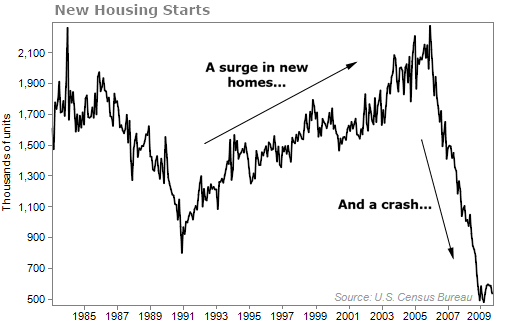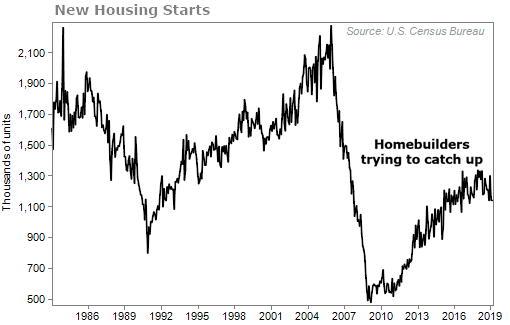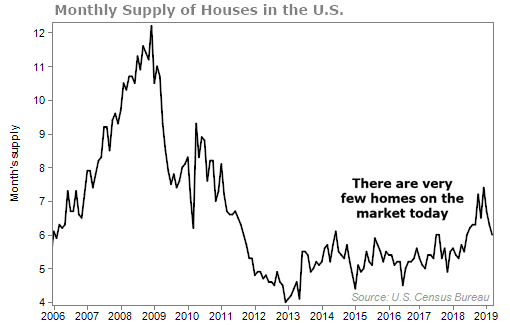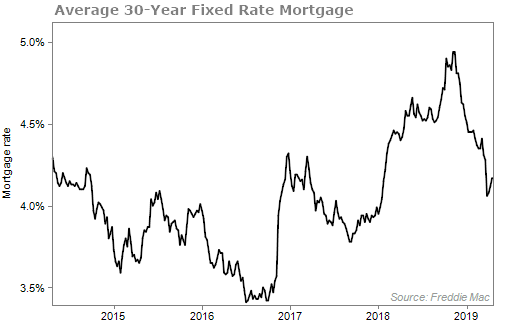In early 2018, the housing market was booming.
Prices for existing homes were on the rise. Sales were brisk. And builders kept planning more construction.
Then came news earlier this week that existing home sales fell 5% last month. But the problem isn't that people don't want to buy houses... It's that there aren't enough houses to buy.
Simply put, the demand is there, but the supply is not. And that's going to lead to rising prices.
To understand this, let's have a quick and easy Economics 101 lesson...
When demand exceeds supply, prices rise to bring the relationship back into equilibrium. There are very few times when you see an imbalance in a supply and demand relationship.
Since we have a free market in the U.S., supply should typically always meet demand. After all, if there's demand that's not being met, some entrepreneur will find a way to satisfy it. But we're not seeing that today in one industry.
We saw that the economics didn't look right years ago and we've been writing about it since then. It's created a buying opportunity...
There was a homebuilding boom in 2000-2005 because demand for homes was through the roof. Everyone needed to have that new five-bedroom house, so housing starts – an indicator that reflects how many new homes are being built – skyrocketed...

Then the housing market collapsed. And we saw new home construction crash during the recession.
But the economy slowly began to recover after 2010. Unemployment began to drop. Wages slowly started to increase. Consumers started to gain confidence. They started spending again. And they were ready to buy new homes...
The only problem is that homebuilders didn't build enough homes...

Even though housing starts gradually increased, demand far exceeds supply.
The problem isn't that there aren't enough people selling homes to match the number of buyers... It's for lack of inventory.
The chart below shows the ratio of houses for sale versus houses sold. When the ratio is low, it tells us that buyers have few homes to choose from...

The homes that are on the market are extremely old, too. According to the National Association of Home Builders, the median age of owner-occupied homes in the U.S. is more than 35 years. More than half of all homes were built before 1980 and 38% were built before 1970.
When potential home buyers – that have benefitted from a growing economy and a raging bull market – are looking for new homes, a 30- or 40-year-old house isn't first on their list. They want something new – a house that doesn't need constant maintenance and repairs.
The point is that there are too few homes buyers want on the market today. More homes need to be built... Period.
Another positive for the housing market is mortgage rates. Mortgage rates have dropped in recent months, which makes homes more affordable to buy.

Just a few months ago, rates were close to 5%. While a 1% difference may not seem like much, it can add more than $100 to a standard monthly loan payment (assuming a 20% down payment on a $300,000 home). Over the course of 30 years, that's tens of thousands of dollars.
Again, we've been talking about this situation since 2017. The story just made sense to us. And we've profited from it, too.
We've closed multiple trades in my options-selling service Retirement Trader for profits and are up nearly 40% on a housing-related stock recommendation that we opened in April 2018 in my Retirement Millionaire advisory.
I think there's more profits to come.
The setup for homebuilders is just too good to pass up. And stocks that are involved in home improvement will benefit as well. The houses on the market right now are just too old.
If you have some extra cash floating around and want to put it to use, I think a play on housing is a smart move.
What We're Reading...
- Something different: The art and science of blending.
Here's to our health, wealth, and a great retirement,
Dr. David Eifrig and the Health & Wealth Bulletin Research Team
April 24, 2019
